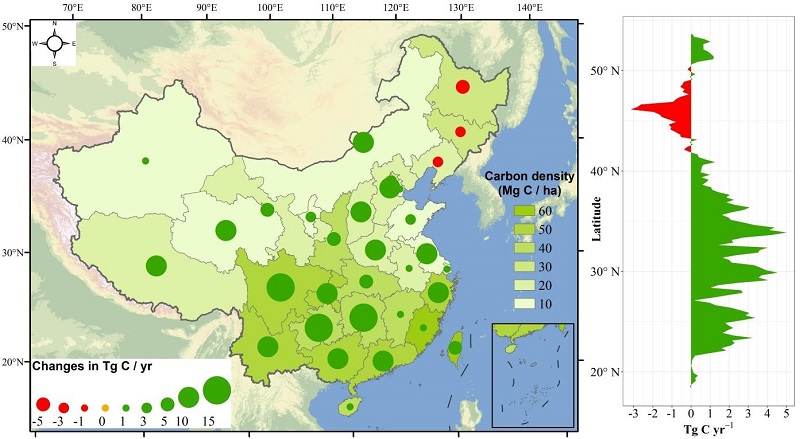Estimating Aboveground Carbon Dynamic of China Using Optical and Microwave Remote Sensing Datasets from 2013 to 2019
Over the past two to three decades, Chinese forests are estimated to act as a significant carbon sink, yet the magnitude and spatial patterns of this sink differ considerably among studies. Using three microwave (L- and X-band vegetation optical depth (VOD)) and three optical (normalized difference vegetation index, leaf area index, and tree cover) remote sensing vegetation products, this study compared the estimated live woody aboveground biomass carbon (AGC) dynamics over China between 2013 and 2019.
The results showed that tree cover has the highest spatial consistency with three published AGC maps (mean correlation value R = 0.84), followed by L-VOD (R = 0.83), which outperform the other VODs. An AGC estimation model was proposed to combine all indices to estimate the annual AGC dynamics in China during 2013-2019. The performance of the AGC estimation model was good (RMSE = 0.05 Pg C and R2 = 0.90 with a mean relative uncertainty of 9.8% at pixel-scale (0.25°)). Results of the AGC estimation model showed that carbon uptake by the forests in China was about +0.17 Pg C yr-1 from 2013 to 2019 (Figure 1). At regional level, provinces in southwest China including Guizhou (+22.35 Tg C yr-1), Sichuan (+14.49 Tg C yr-1), and Hunan (+11.42 Tg C yr-1) provinces had the highest carbon sink rates during 2013-2019. Most of the carbon-sink regions have been afforested recently, implying that afforestation and ecological engineering projects have been effective means for carbon sequestration in these regions.
The relevant research entitled “Estimating Aboveground Carbon Dynamic of China Using Optical and Microwave Remote-Sensing Datasets from 2013 to 2019” has been published in Journal of Remote Sensing. Dr. Zhongbing Chang from the South China Botanical Garden of CAS is the first author of this paper, Professor Lei Fan from Southwest University and Professor Junhua Yan from the South China Botanical Garden of CAS are the corresponding author of the paper. This study was supported by the National Science Fund for Distinguished Young Scholars (41825020), the National Natural Science Foundation of China (42171339). For more details, please refer to: https://spj.science.org/doi/10.34133/remotesensing.0005

File Download: